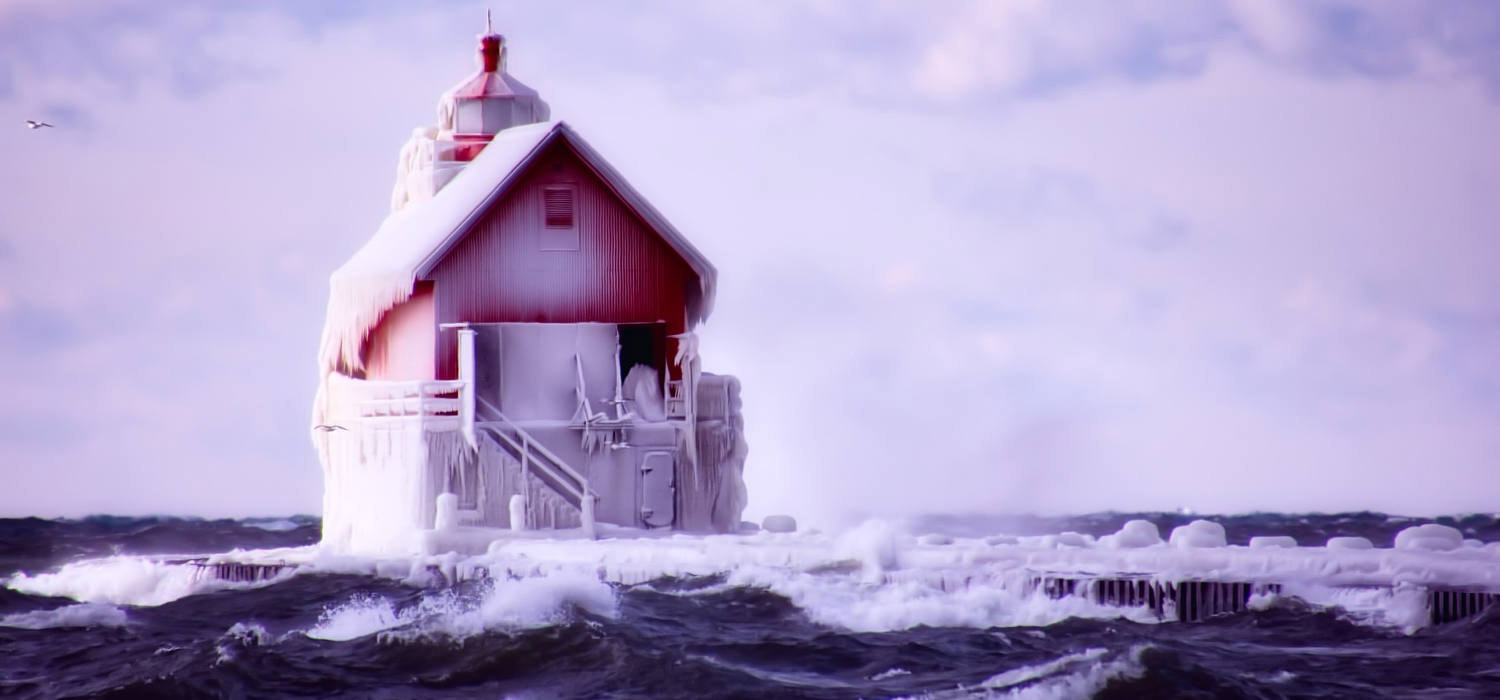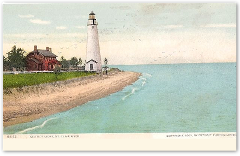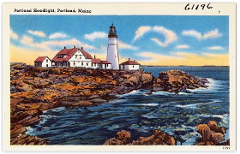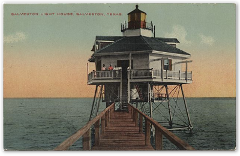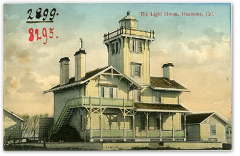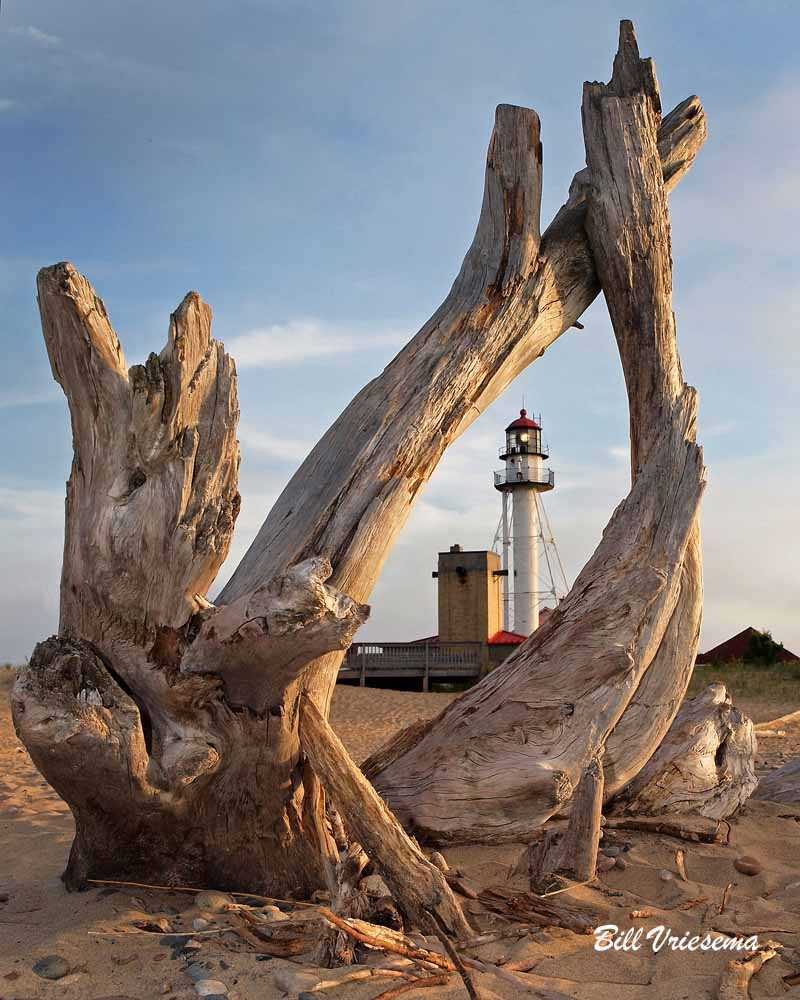Image Source - Bill Vriesema (Some rights reserved)
(Wikipedia)
The Whitefish Point Light, a lighthouse in the Upper Peninsula of Michigan, is the oldest operating light on Lake Superior. It is arguably the most important light on Lake Superior. All vessels entering and leaving Lake Superior must pass the light. It stands on the treacherous southern shoreline of Lake Superior known as the "Graveyard of the Great Lakes" in an area with more shipwrecks than any other area of the lake.
(USCG)
WHITEFISH POINT LIGHT, MICHIGAN
Location: WHITEFISH BAY/LAKE SUPERIOR
Station Established: 1848
Year Current Tower(s) First Lit: 1861
Operational? YES
Automated? YES 1970
Deactivated: n/a
Foundation Materials: CONCRETE/PILE
Construction Materials: CAST IRON
Tower Shape: SKELETAL
Markings/Pattern: WHITE W/RED ROOF
Relationship to Other Structure: ATTACHED
Original Lens: THIRD ORDER, FRESNEL 1857
History
(Wikipedia)
Construction on the first light began in 1847, and the lighthouse was said to resemble that at Old Presque Isle Light. First lit in 1849, it was one of the first lighthouses on the shores of Lake Superior. It is the oldest active light on the lake, standing at the point of land that marks the course change for vessels coming from the southern coast of Lake Superior, known as the "Graveyard of the Great Lakes", to the Soo Locks. All vessels entering or leaving Lake Superior must past Whitefish Point. Whitefish Point Light is arguably the most important light on Lake Superior. The Whitefish Point area has more shipwrecks than any other area in Lake Superior.
The original structure was outfitted with Lewis lamps, which were thereafter upgraded to a fourth order Fresnel lens. The current structure, while modern looking, is a Civil War relic. Built in 1861, the iron skeletal steel framework was designed to relieve stress caused by high winds. A similar design is used at Manitou Island Light in Lake Superior. It was equipped with a third order Fresnel lens.
In 1968, the light was replaced with a DCB-224 aero beacon manufactured by the Carlisle & Finch Company. According to Volume 7 of the U.S. Coast Guard light list, it was visible for a distance of 26 nautical miles (48 km; 30 mi) in clear weather conditions, and had two unevenly spaced eclipses, and two flashes within every 20 second period. Putting aside questions of nostalgia, aesthetics, or appreciation for the engineering of a bygone era (as exemplified by the Fresnel lens), this iteration of lighthouse illumination was itself incredibly effective, and an endangered remnant of another bygone era.
The station was automated in 1971.
In 2011, the U.S. Coast Guard Local Notice to Mariners reported reduced intensity of the Whitefish Point light from June 7, 2011 until August 16, 2011, when the DCB-224 Series Carlisle & Finch aerobeacon lens was changed to a light-emitting diode (LED) lantern with a reduced range of 15 nautical miles (28 km; 17 mi) as permitted by Coast Guard rules and regulations adopted in 2003 for private aids to navigation. The aerobeacon lens is stored in a building at the Great Lakes Shipwreck Museum complex for possible future public display.

The lighthouse is home to the Great Lakes Shipwreck Museum, which has many artifacts from numerous shipwrecks in the Whitefish Point Underwater Preserve, most notably, the bell from the SS Edmund Fitzgerald, which was recovered from the wreck in 1995. The Great Lakes Shipwreck Museum is open during the tourist season from 10 am to 6 pm, every day through October 31. The organization that operates the museum got 80.079% of its funding from the public in the year 2010.
The light is considered iconic, and has been the subject of memorabilia. An official Michigan Historical Marker was erected in 1974. It is Registered Site L0272. The marker notes:
This light, the oldest on Lake Superior, began operating in 1849, though the present tower was constructed later. An early stopping place for Indians, Voyageurs, Coureur des bois and Jesuit missionaries, the point marks the course change for ore boats and other ships navigating this treacherous coastline to and from St. Mary's Canal. Since 1971 the light, fog signal, and radio beacon have been automated and controlled from Sault Ste. Marie.
Images by David Marvin (Flickr - Some rights reserved)
USCG Historical Key Points:
- 1847 - $5,000 appropriated to build the lighthouse.
- 1848 – Construction began on stone tower. The final cost was $8,298.
- 1849 – The light was exhibited for the first time from the lantern.
- 1857 – Lamp array changed to 4th order Fresnel lens.
- 1859 – Bill introduced in Congress requesting the Commerce Committee to investigate the possibility of improving the lighthouse.
- 1861 – Construction began on pre-fabricated cast-iron tower.
- 1862 – New tower placed in service.
- 1871 – Fog signal building constructed.
- 1893 – Characteristic changed from fixed to flashing.
- 1895 – Keeper’s house changed to duplex.
- 1896 – Fog signal building renovated.
- 1905 – New corrugated iron fog signal building built.
- 1935 – Fog signal building destroyed in storm.
- 1936 – Brick fog signal building built.
- 1937 – Protective piers built along the shoreline.
- 1968 – Fresnel lens removed and DCB224 aerobeacon installed.
- 1971 – Station automated.
- 1973 – Placed on National Register of Historic Places.
- 1985 – Great Lakes Shipwreck Museum established at site.
(USCG) Keepers:
- 1848-1849: James Starr
- 1849-1851: James B. Van Renselaer
- 1851-1853: Amos Stiles
- 1853-1856: William C. Crampton
- 1856-1859: Belloni McGulpin
- 1859-1861: Charles Garland
- 1861-1864: Joseph Kemp
- 1863-1864: Charles Caldwell (1st assistant)
- 1864-1868: Thomas Stafford
- 1864-1868: E. Stafford (1st assistant)
- 1868-1874: Edward Ashman
- 1868-1874: Reuben Ashman (1st assistant)
- 1874-1882: Charles J. Linke
- 1874-1875: Thomas Tate (acting 1st assistant)
- 1875-1876: Richard Russell (1st assistant)
- 1876-1879: Nicholas Gengrew (1st assistant)
- 1879-1883: Joseph Linke (1st assistant)
- 1882-1883: Edward Chambers
- 1883-1903: Charles Kimball
- 1883-1895: Alonzo Kimball (1st assistant)
- 1894-1895: Charles Schulz (acting 2nd assistant)
- 1895-1897: Charles Schulz (1st assistant)
- 1896-1899: Donald Harrison (2nd assistant)
- 1897-1901: William Bennett (1st assistant)
- 1899-1901: James Kay (2nd assistant)
- 1902: Alfred Evenson (2nd assistant)
- 1902-1905: James Kay (1st assistant)
- 1903-1931: Robert Carlson
- 1903-1904: Charles Price (2nd assistant)
- 1904: William Mabee (2nd assistant)
- 1904-1905: Klass Hamringa (2nd assistant)
- 1905-1910: Herbert Crittenden (1st assistant)
- 1905-1906: Henry Noel (2nd assistant)
- 1906: William Duggan (2nd assistant)
- 1906-1907: John Clarke, Jr. (2nd assistant)
- 1907: Frederick Burnham (2nd assistant)
- 1907: Joseph Pigeon (2nd assistant)
- 1907-1908: William Gates (2nd assistant)
- 1908-1911: Arthur Clement (2nd assistant)
- 1910-1913: Frank Mersy (1st assistant)
- 1911: George Frederick (2nd assistant)
- 1911-1912: Edward Nordstrom (2nd assistant)
- 1922-1929: Carl Hagstrom (2nd assistant)
- 1923-1928: Peter Day (1st assistant)
- 1929-1939: (first name unknown) Robinson (2nd assistant)
- 1931-1933: Harry House
- 1933-1939: Charles Lewis
- 1936-1938: Wilbur Ranville (1st assistant)
- 1938-1941: Louis DeRusha (1st assistant)
- 1939-1940: Joseph Schmitz (2nd assistant)
- 1939-1941: William Campbell
- 1941-1947: Samuel Anderson (1st assistant)
Researched and written by Marie Vincent, a volunteer through the Chesapeake Chapter of the U.S. Lighthouse Society.
Content Courtesy of the US Coast Guard Historian's Office (USCG) And Wikipedia

